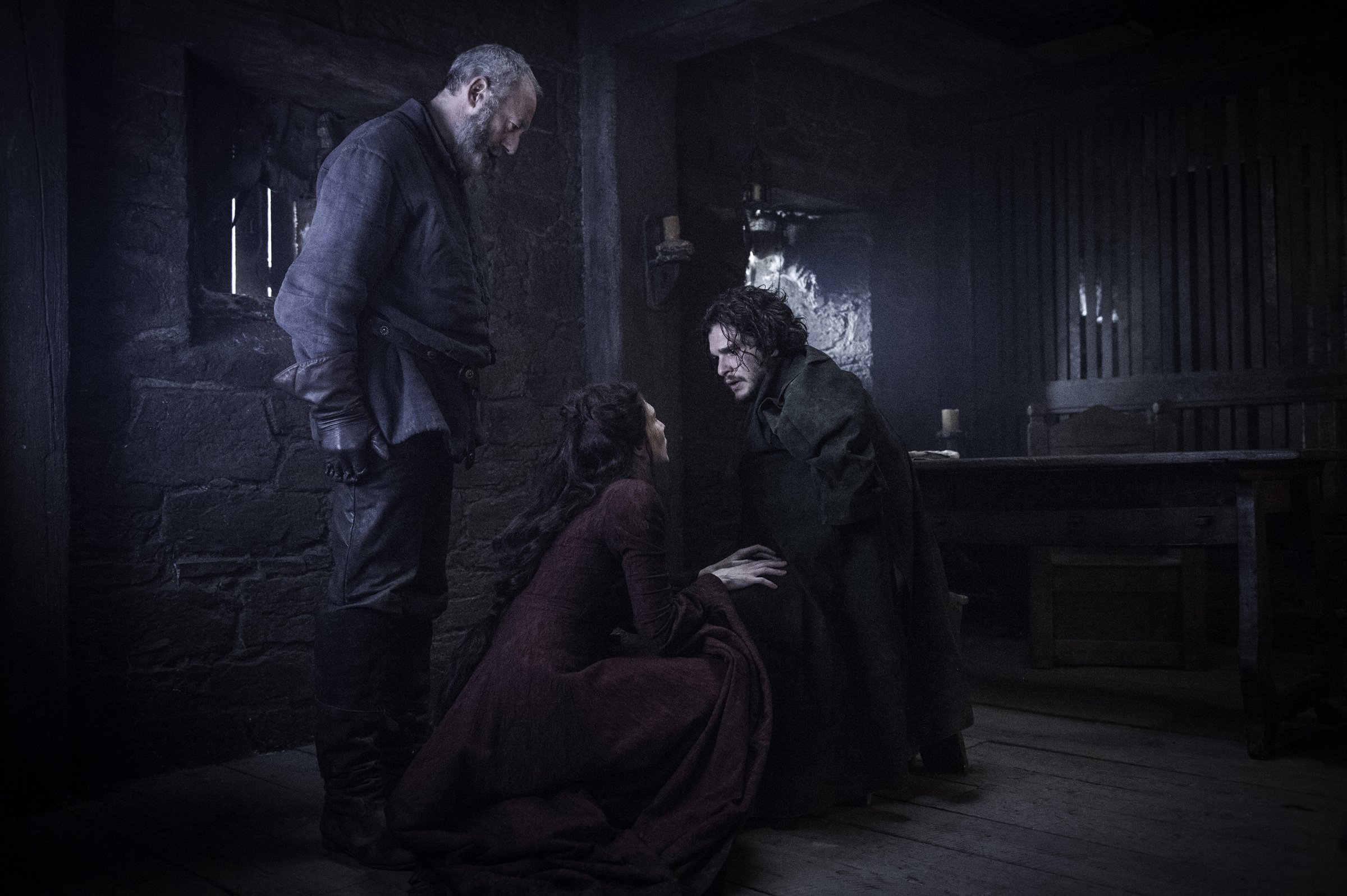
Game of Thrones boasts the most eclectic ensemble on TV—but everyone knows Jon Snow is the star. Made endearing with a troubled backstory, elevated to heroism by his moral compass and blessed with actor Kit Harington’s waterfall of dark tresses, Jon is the closest thing HBO’s Sunday night has to a matinee idol.
That is, until he was. And now he is again. Killed by a Caesar-like flurry of stab wounds in the fifth-season finale, Jon was resurrected a mere two episodes into the new season thanks to a magic spell. And though Melisandre, the priestess who brought him back, was shocked by Jon’s reanimated status, few at home were.
Some of it was this show’s long-standing embrace of magic. Some of it was that in a world of paparazzi zoom lenses and social media, Harington’s presence at Thrones shooting locations couldn’t stay secret for long, and his own protestations—that Jon was really dead and never coming back!—couldn’t help but seem hollow. But nearly a year’s worth of fan certainty that the late commander of the Night’s Watch would return seemed in large part governed by the sense that no character fans loved so ardently could actually die.
Sure, earlier seasons of the show featured shocking and decisive ends for beloved characters, from protagonist Ned Stark’s beheading in Season 1 to the high-body-count “Red Wedding” of Season 3. But Game of Thrones’ increased dithering over what to do with its characters reflects this era of pop culture Tinker Bells—as long as we clap hard enough, they’ll keep coming back.
At the movies, Marvel’s never-ending superhero franchise thrives on creating threatening situations for characters we know are under contract for the next one. (Clark Gregg’s Agent Coulson, who died in 2012’s The Avengers, now headlines ABC’s Marvel’s Agents of S.H.I.E.L.D.) And in The Walking Dead’s most recent season, fan favorite Glenn, believed devoured by zombies, was revealed to be alive thanks to an implausible escape. The season ended with an unseen character getting bludgeoned; surely in the interim, the show’s writers will figure out which of their characters are vulnerable and which are too popular to die.
Thrones fans were well informed, and correctly so, about Jon’s revival. But there was something more at work than knowledge of Harington’s real-life location and Westeros’ rules. There was also a fair amount of magical thinking—and not the sort that Melisandre does. From the minute Jon died, speculation about whether he was really gone made it clear that no character so widely loved by the fan base could be allowed to go away.
Jon’s presence is especially welcome on a show that needs his selflessness to balance just about every other character’s narcissism. If his absence could have generated drama that transcended formula, we’ll never know. Lately, the show has been investing a great deal of narrative energy into tormenting and killing peripheral characters, while the stars stride along in bubbles of perpetual safety. Death has become something that befalls only the insignificant. If this really is a game, someone we care about is eventually going to have to lose.
The only other characters as well loved as Jon—the dragon mother Daenerys and the clever dwarf Tyrion—have never died but have lived through nonstop treacherous events unscathed. Game of Thrones, so eager to give fans what they want, has been dragging its feet about winding its story down, adding to its minor-character body count and its list of repetitive incidents even as its plots seem to demand some closure. Endless reversals keep the plot humming at the expense of sense, and perhaps viewer patience.
The Red Wedding, today, feels as if it happened on a different show, one less concerned about stretching out plot and avoiding endings. After more than half a decade on the air, Game of Thrones is no longer inclined to show an onscreen death as jarring, random and decisive as a death in real life.
And so the show backed away. But there should have been some other way to depict Jon’s betrayal, if his death was to be reversed so quickly. Why bring death into the equation at all? It is, or should be, different—life’s defining traumatic event, and one with the power to reshape everyone it touches. That Jon comes back to life unchanged, but for his new sense of resentment, is a missed opportunity for the sort of seismic change that the best TV isn’t afraid to take on. “I failed,” the resurrected Jon tells his friend Davos. “Good. Now go fail again,” the knight replies. Recursiveness is the last thing a show staggering toward its endgame needs.
In his first hours newly alive, Jon is carrying out the show’s violent vision again. He executes those who conspired against him, answering death with death. As a vengeful Jon strode away from the castle he’d commanded and into an uncertain future, one thing seemed clear: he’d be fine.
One of his executed prisoners’ final words, before the gratuitously violent execution scene, still resonated. “You shouldn’t be alive,” the prisoner had said. “It’s not right!” Even those among the show’s legion of fans who consider Jon a favorite had to concede he made a good point. But, being a minor character, he died before he could say anything further.
More Must-Reads From TIME
- The 100 Most Influential People of 2024
- The Revolution of Yulia Navalnaya
- 6 Compliments That Land Every Time
- What's the Deal With the Bitcoin Halving?
- If You're Dating Right Now , You're Brave: Column
- The AI That Could Heal a Divided Internet
- Fallout Is a Brilliant Model for the Future of Video Game Adaptations
- Want Weekly Recs on What to Watch, Read, and More? Sign Up for Worth Your Time
Contact us at letters@time.com